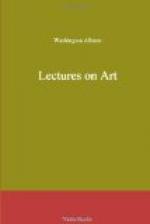That some such power is inherent and fundamental in our nature, though differenced in individuals by more or less activity, seems more especially confirmed in this latter branch of the subject, where the phenomena presented are exclusively of the Possible. Indeed, we cannot conceive how without it there could ever be such a thing as true Art; for what might be received as such in one age might also be overruled in the next: as we know to be the case with most things depending on opinion. But, happily for Art, if once established on this immutable base, there it must rest: and rest unchanged, amidst the endless fluctuations of manners, habits, and opinions; for its truth of a thousand years is as the truth of yesterday. Hence the beings described by Homer, Shakspeare, and Milton are as true to us now, as the recent characters of Scott. Nor is it the least characteristic of this important Truth, that the only thing needed for its full reception is simply its presence,—being its own evidence.
How otherwise could such a being as Caliban ever be true to us? We have never seen his race; nay, we knew not that such a creature could exist, until he started upon us from the mind of Shakspeare. Yet who ever stopped to ask if he were a real being? His existence to the mind is instantly felt;—not as a matter of faith, but of fact, and a fact, too, which the imagination cannot get rid of if it would, but which must ever remain there, verifying itself, from the first to the last moment of consciousness. From whatever point we view this singular creature, his reality is felt. His very language, his habits, his feelings, whenever they recur to us, are all issues from a living thing, acting upon us, nay, forcing the mind, in some instances, even to speculate on his nature, till it finds itself classing him in the chain of being as the intermediate link between man and the brute. And this we do, not by an ingenious effort, but almost by involuntary induction; for we perceive speech and intellect, and yet without a soul. What but an intellectual brute could have uttered the imprecations of Caliban? They would not be natural in man, whether savage or civilized. Hear him, in his wrath against Prospero and Miranda:—
“A wicked dew as e’er my mother
brushed
With raven’s feather from unwholesome
fen,
Light on you both!”
The wild malignity of this curse, fierce as it is, yet wants the moral venom, the devilish leaven, of a consenting spirit: it is all but human.
To this we may add a similar example, from our own art, in the Puck, or Robin Goodfellow, of Sir Joshua Reynolds. Who can look at this exquisite little creature, seated on its toadstool cushion, and not acknowledge its prerogative of life,—that mysterious influence which in spite of the stubborn understanding masters the mind,—sending it back to days long past, when care was but a dream, and its most serious business a childish frolic?




